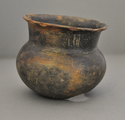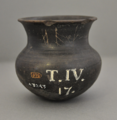VA·5
| Inscription | |
|---|---|
| Reading in transliteration: | ??? |
| Reading in original script: | ??? |
|
| |
| Object: | VA·5 Golasecca (beaker) |
| Position: | neck, outside |
| Orientation: | 0° |
| Direction of writing: | ambiguous |
| Script: | none |
| Letter height: | 1.9–3 cm0.748 in <br />1.181 in <br /> |
| Number of letters: | 3 |
| Number of lines: | 1 |
| Workmanship: | scratched after firing |
| Condition: | complete |
|
| |
| Archaeological culture: | Golasecca II B [from object] |
| Date of inscription: | second half of the 6th c. BC [from object] |
|
| |
| Type: | unknown |
| Language: | none |
| Meaning: | unknown |
|
| |
| Alternative sigla: | Solinas 1995: 118 Morandi 2004: 79 |
|
| |
| Sources: | Morandi 2004: 574 no. 79 |
Images
|
| ||||
Commentary
First published in Giani 1824: 25, 170. Examined for LexLep on 27th of April 2022.
Images in Giani 1824: 25 = 170 and tav. IV.17 (drawing = [traced] Mommsen 1853: Taf. III.40 = CII: iii, no. 7), Garovaglio 1883: fig. 21 (drawing = [traced] Gambari & Colonna 1988: 160, fig. 23).
Three characters inscribed on the neck of the beaker (lenth 4.2 cm). They were published by Giani as one of a number of inscriptions on finds from the Golasecca necropolis (1824: 25 f., 170, drawings tav. IV.15–20, 1825: 66 f., drawings 71, no. 1–12). Giani, who believed his finds to be connected with the Battle of Ticinus, identified the characters in his inscriptions as Etruscan, and read the three discreet ones of the present inscription as (dextroverse) Latin TI.E.FI. = Tiberius Equitis Filius (p. 170). The alphabetic nature of the inscriptions published in 1824, with drawings showing a mix of very basic and overly complex characters, was doubted by a reviewer in Bibliotheca Italiana; Giani defended his readings in 1825 (p. 16–18), though the second batch of inscriptions is even less convincing. Mommsen 1853: 216 f., who reproduces five drawings in his Taf. III (no.s 39–43), asked the opinion of Bernardino Biondelli, who wrote to him in a letter that "[l]e iscrizioni non hanno mai esistito, se non nella mente visionaria dell'autore, che trasportato da' suoi sogni ha veduto ciò che nessun altro vide". The only one of Giani's inscriptions that Biondelli could find was the present one, which he was certain was applied by Giani himself: "la freschezza della graffitura è troppo evidente, non che la mano inesperta che tentò imitare qualche lettera arcaica od etrusca senza sapere che cosa si facesse". Biondelli stresses that he examined all vessels found by Giani, himself, and others at Golasecca, and that not a single one bears an inscription. Mommsen adds that the placement of many of the alleged scratchings inside the vessels as well as Giani's imaginative Latin interpretations are suspicious. The five drawings reproduced by Mommsen are also included in CII as inscriptions 6–10 (the present one no. 7), following Mommsen in the comment "litterae deformatae [...], fortasse recentiori manu". Garovaglio 1883: 21, no. 21, observing that the inscription was published "poco esattamente" by Giani, provides a new drawing, which shows an additional vertical scratch to the left and more scratches in the rightmost character. Garovaglio's remark "[g]raffito a, b, c, d" is unclear to me, as such a reading is evidently impossible.
The letter forms as drawn by Garovaglio are mentioned in passing by Whatmough PID: 103 f. (note xvi, prob. k and m) and Lejeune 1971: 15, n. 44. Gambari & Colonna 1988: 133, n. 59 express their conviction that Giani's inscriptions are authentic (the present one being the only usable one because of Garovaglio's redrawing), arguing that Biondelli was not an epigraphist and also doubted the authenticity of MI·6, and that Mommsen was prejudiced against Giani because of the latter's mediocrity as a Latinist. Based on Garovaglio's drawing, they (160, no. 2) give a tentative reading (dextroverse) iḥeχ, uncertain due to the difficulty of distinguishing intentional from unintentional scratches and the fact that heta is not otherwise attested in the Lepontic alphabet. De Marinis 1986b: 76, n. 55, with reference to Giani's original drawing, gives a reading of the inscription as aev, i.e. a (putative) pars pro toto Lepontic alphabetarium as attested twice in the 5th century at Prestino (see the word page), leading Prosdocimi 1990: 297 to suspect that the document got mixed up with CO·53 aev, which had just been published by De Marinis, because "un aev non può essere cessato da una parte e rispuntare da un'altra". Similarly, Morandi 1999: 177, n. 87 assumes that De Marinis' reading aev is due to an error in the description of CO·53 Prestino as black-glazed ware, which caused it to be confused with the present document. It is easily conceivable, however, how De Marinis could have seen aev in Giani's drawing, even though this is quite impossible from Garovaglio's. That De Marinis' reading is inexplicable from Garovaglio's drawing does appear to have caused Solinas 1995 to reproduce a drawing of CO·53 sub n. 118 with data which clearly pertains to the present document; the two documents are also conflated by Eska 1998c: 65, n. 10.
Our examination of this and two other inscriptoids on black-glazed beakers excavated by Giani at Golasecca (inv. no.s A 0.9.3301, A 0.9.3109) has shown that there is no reason to assume that the incised characters are not ancient. Indeed, the judgements of Biondelli and Mommsen are rather harshly put and may well betray a preconceived inclination to dismiss Giani's work; as observed by De Mortillet 1865: 465 f., Biondelli's claim that the scratching looked recent is not much to go by, and it is hard to see why Giani should have forged an inscription – if he had, he would surely have incised the letters he put in his drawing rather than the scraggly characters we find on the beaker. Castelfranco 1876: 99 suggested that maybe somebody other than Giani forged inscriptions with a view to selling them, pointing particularly to Giani's no. 15, whose characters "non mi ispirano alcuna fiducia"; however, he notes that he himself unearthed pottery with marks which sometimes resemble, but are not really letters, with examples in tav. III.27 and 28 (the latter in the corpus as VA·32).
Garovaglio's drawing is quite accurate. The single vertical scratch on the left is 5 cm long and 2.6 cm distant from the heta-like character. While the three more complex characters, especially the ![]() -shape in the centre, vaguely resemble Etruscan/North Italic letters, the one on the right is in fact an asterisk, while the one on the left could only be heta, which does not exist in the lepontic alphabet. The document clearly belongs with the group of small beakers and pitchers from the Golasecca necropolis, with marks usually on the neck, excavated by Giani and Castelfranco. The other two Giani finds kept at the Civico Museo Archeologico (Milano) (which are not among the "inscriptions" reproduced in Giani's publications mentioned above) bear the marks
-shape in the centre, vaguely resemble Etruscan/North Italic letters, the one on the right is in fact an asterisk, while the one on the left could only be heta, which does not exist in the lepontic alphabet. The document clearly belongs with the group of small beakers and pitchers from the Golasecca necropolis, with marks usually on the neck, excavated by Giani and Castelfranco. The other two Giani finds kept at the Civico Museo Archeologico (Milano) (which are not among the "inscriptions" reproduced in Giani's publications mentioned above) bear the marks ![]()
![]()
![]() and
and ![]()
![]()
![]() , respectively, on the neck. See VA·32 for the marks from the Castelfranco collection. Arguably the latter and VA·5 are among the marks whch include comparatively letter-like characters, and examples for language-encoding inscriptions on similar beakers exists in NO·1 and (probably) the difficult-to-read VA·4.1/VA·4.2 – in fact, VA·5 does not look all that different than VA·4.2 with its five lines which are superfluous to the proposed Etruscan/Lepontic readings. Still, the present marks are highly unlikely to be script (the reading aev can be excluded anyway, pace Motta 2000: 209, no. 15). The characters are likely non-script marks or possibly pseudo-script (cf. Morandi 2004).
, respectively, on the neck. See VA·32 for the marks from the Castelfranco collection. Arguably the latter and VA·5 are among the marks whch include comparatively letter-like characters, and examples for language-encoding inscriptions on similar beakers exists in NO·1 and (probably) the difficult-to-read VA·4.1/VA·4.2 – in fact, VA·5 does not look all that different than VA·4.2 with its five lines which are superfluous to the proposed Etruscan/Lepontic readings. Still, the present marks are highly unlikely to be script (the reading aev can be excluded anyway, pace Motta 2000: 209, no. 15). The characters are likely non-script marks or possibly pseudo-script (cf. Morandi 2004).
See also Salomon 2024b: 31–36.
Bibliography
| Castelfranco 1876 | Pompeo Castelfranco, "Due periodi della 1a Età del Ferro nella Necropoli di Golasecca", Bullettino di Paletnologia Italiana 2,1 (1876), 87–106. |
|---|---|
| CII | Ariodante Fabretti, Corpus inscriptionum italicarum antiquioris aevi. Ordine geographico digestum et glossarium italicum, in quo omnia vocabula continentur ex umbricis, sabinis, oscis, volscis, etruscis aliisque monumentis quae supersunt, Augusta Taurinorum: 1867. |
| De Marinis 1986b | Raffaele De Marinis, "I commerci dell'Etruria con i paesi a nord del Po dal IX al VI secolo a.C.", in: Raffaele De Marinis (ed.), Gli Etruschi a nord del Po. Mantova Palazzo Ducale - Galleria dell'Estivale, 21 settembre - 12 gennaio 1987, Mantova: 1986–1987. (catalogo della mostra, 2 volumes: vol. I 1986, vol. II 1987), I 52–80. |
| De Mortillet 1865 | Gabriel de Mortillet, "Sépultures anciennes du plateau de Somma (Lombardie)", Révue Archéologique N.S. 12 (1865), 453–468. |
| Eska 1998c | Josef Francis Eska, "PIE *p (doesn't become) Ø in proto Celtic", Münchener Studien zur Sprachwissenschaft 58 (1998), 63-80. |







